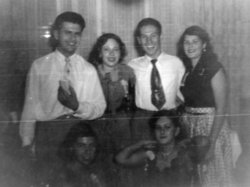
MAY CONTAIN NUTS

Search Shorpy
SHORPY ART

Framed or unframed, desk size to sofa size, printed by us in Arizona and Alabama since 2007. Explore now.
Join and Share
Ad-Free Shorpy
Shorpy is funded by you. Patreon contributors get an ad-free experience.
Learn more.

Recent comments
- Those standpipes
- Wrenches
- International D-40 I believe
- Job prospects
- You had me at Train
- Land of the free
- Broad-Exchange Bldg
- Parking innovation
- The old block
- "Peck turned a sweet propeller"
- National Bank Building
- Notch shot
- Straight ahead (right, left, left, right)
- Ship lifespans
- New service
- You Say Station, I Say Potato ...
- Iron Age
- Thank you, Cornelius Vanderbilt
- Grand Central Terminal
- If they made a movie of it
- Obsolete by then.
- Half the tonnage at the NYPANO dock
- Ravages escaped, bank notes signed and dated
- Chatham expansion
- Steepled in History
- Made by York
- No Summer Vacation
- Wait a minute ...
- $$$
- Joad on the Road
Member Photos
The Shorpy
Printporium
Printporium
Search Shorpy
Search results -- 30 results per page
- Death Star: 1902
- ... are an awful lot of open windows.
It Hyphened One Night The Waldorf-Astoria was originally built as 2 separate hotels by ... Posted by Dave - 06/25/2023 - 12:40pm -
![Death Star: 1902 Circa 1902. "The Waldorf-Astoria, New York." The original, and somewhat forbidding, Waldorf at Fifth Avenue and 34th Street. Complete with the obligatory windowsill milk bottle. 8x10 inch dry plate glass negative, Detroit Photographic Company. View full size.
OK - I give up.What's an "obligatory windowsill milk bottle?"
[A familiar sight on these pages. Left out to chill. - Dave]
It stood for less than 40 yearsTorn down in 1929 to make way for the Empire State Building.
The storks also deliver milk!It's amazing that, in addition to tiny babes, the storks are also adept at delivering windowsill milk bottles.... 7 stories high!
34th StreetThe street on the north side, the one with the trolley, appears narrower than it is today. It may be an optical illusion but it seems to be missing a lane on both sides. Today 34th Street is one of the busiest in the city, leading east to the Queens-Midtown Tunnel and Long Island and west to the world's largest store, Macy's, and continuing to the Lincoln Tunnel to New Jersey and points beyond. This of course, takes nothing away from the magnificent old Waldorf or its successor, the landmarked Empire State Building.
Police HatAlways a little tip-off on the season to check the hats of the cops. The gray ones were worn in summer, blue in Winter. Likewise with the straw hats. There was a season for them, much like we used to say about white pants. There was the famous "straw hat riot" in 1922 where a bunch of street toughs started ripping the skimmers off men who'd worn them after the agreed-upon cut-off date.
[Probably the best seasonal tipoff: Windowsill milk bottles! - Dave]
v = ?(2gx)Given the generous "no walk" zones at sidewalk level, do you
suppose the engineers took the milk bottle "Oops Factor" into
consideration?
Movie SetLooks like Sigourney Weaver's apartment building in "Ghostbusters."
[Which was on Central Park West. - Dave]
It may be cold outside but it's sure hot in here!I guess the steam heat was cranking because there are an awful lot of open windows.
It Hyphened One NightThe Waldorf-Astoria was originally built as 2 separate hotels by feuding members of the Astor family. The Waldorf on the left (the shorter half) was built in 1983 1883, and the Astoria on the right was completed in 1897. The two were soon operated as one hotel, but it's apparently possible to separate them back into two distinct entities if needed.
One assumes that ..you could get a Waldorf Salad here. And screwdrivers.
The Waldorf SaladIt seems like Doghouse Riley has been watching too many Fawlty Tower reruns, as well as myself. The Waldorf Salad episode is one of my favorites.
Astor CourtThe banner on top of the short building on the right probably reads "Astor Court" - not "Astoria." The Astor Court Building stood just west of the private alley (also called Astor Court) that separated it from the Waldorf-Astoria Hotel. All of this became part of the site of the Empire State Building.
Tricks of the House WreckersModern Mechanics featured the demolition of the Waldorf Astoria in the June 1930 issue. Click to enlarge.
Penthouse ViewsWhat would the uses of the top several floors be in this building? They are very unusual; the arrangement, size and shape of the top floor windows.
Actuallythe name was the Waldorf=Astoria! The "=" sign was put in because the cousins who built the two side by side hotel couldn't agree on whose name would be first in the new name!
I would have loved to have stayed here, even in the smallest room.
The old family homesteadAccording to an old family legend, an ancestor of mine once had his farm at this location in the early 19th century. I'm sure he'd kick himself If he could see what the property values were now!
What a beauty!I'd like to live there those times and see it with my own eyes!
Maitre d' MarcosMy grandfather Marcel Burgos was maitre d' for this Waldorf for many years during the 1920s. My dad told many stories about him. Anybody out there have any records of any employes from there?
(The Gallery, DPC, NYC, Streetcars)](https://www.shorpy.com/files/images/4a09397a.thumbnail.jpg)
- Cajun Girls' Night Out: 1938
- October 1938. "Girls from the Cajun country at Raceland, Louisiana." 35mm negative by Russell Lee for the Farm Security Administration. View full size.
Horses and Mules Love the calendar in the background. Horses and Mules ... "The usua ... Posted by Dave - 04/10/2008 - 9:31pm -
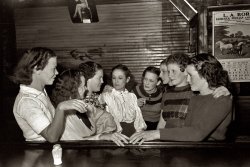
- Night Moves: 1943
- June 1943. Arlington, Virginia. "Girls entertaining their guests in one of the two card rooms at a residence for the women who work in the U.S. government for the duration of the war. More privacy is afforded here than in the main lounge." Photo b ... Posted by Dave - 05/27/2016 - 1:00pm -
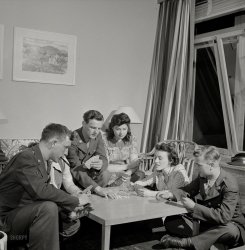
- Night Life: 1942
- April 1942. "Drummer 'Red' Saunders and his band at the Club DeLisa, Chicago." Photo by Jack Delano for the Office of War Information. View full size.
And Red is -- holding his sticks the proper way a drummer should.
Beat Me, Daddy ... Posted by Dave - 12/03/2014 - 1:42pm -
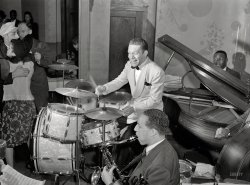
- Night Service: 1942
- Circa 1942, in the vicinity of Washington, D.C.: "Conservation of fuel oil." When the tradesman takes that pencil from behind his ear and uses it as a pointer, you know he's telling you something important. No photographer credit but we will guess ... Posted by Dave - 12/05/2013 - 9:33pm -
![Night Service: 1942 Circa 1942, in the vicinity of Washington, D.C.: "Conservation of fuel oil." When the tradesman takes that pencil from behind his ear and uses it as a pointer, you know he's telling you something important. No photographer credit but we will guess Ann Rosener for the Office of War Information. View full size.
The EquipmentA Bacharach "Fyrite" combustion analyzer, which has something to do with measuring carbon dioxide, or CO₂.
Brand name correction.Feel better Dave? Must be nice to know everything.
[I don't know everything, but I do know the difference between carbon monoxide and carbon dioxide. - Dave]
Shiny oil burnerIt will never be that clean again.
The eyes have itI don't know if I'd want this crazy-looking furnace mechanic in my basement!
They don't make'm like they used to.Boy, this brings back some memories. In 1956 I went to work as a sixteen year old helper for a plumbing and heating contractor. Those threaded pipes behind the mechanic are 1 and 1/4 inch black iron pipe that I had to cut and thread by hand, apply single strand lamp wick and pipe joint compound to the threads. and either hand it to the mechanic or put it together myself, under his direction of course. No copper, sweat/soldering, plastic or glue used here. This is a hot water hydronic heating system as can be confirmed by the "T" shaped fitting on top of the boiler, and the malleable black fittings into which the pipe is screwed. What is missing from the installation is the paper/cardboard insulation on the pipe sections, and then after mixing dry asbestos with water to the consistency of cement, this was troweled on all the fittings in an effort to maintain hot water until it reached the radiators located throughout the building. That right folks dry asbestos floating so thick in the confines of a boiler room or basement, that one could hardly see the other side of the room. Ah, those were the days!
(The Gallery, Ann Rosener, WW2)](https://www.shorpy.com/files/images/SHORPY_8d38148u.thumbnail.jpg)
- Forest Brook: 1956
- ... but to keep enemy bombers from spotting stray lights at night.
And a decade later I started public school a decade later, in a ... Posted by Dave - 02/14/2013 - 7:14am -
![Forest Brook: 1956 November 8, 1956. "Forest Brook Elementary School, Hauppauge, Long Island. Classroom and teacher." For those of a certain demographic, this may strike a chord. Large-format negative by Gottscho-Schleisner. View full size.
We never did that.I grew up in the suburbs around Akron, Ohio, and we never had a bomb drill or duck-and-cover drill ever. All of my peers that grew up in other places had those drills, which has led me to a couple of possible theories. One, that we had some sort of pacifists in our local administration that refused to take part in the Cold War(unlikely). Or two, that we were so close to potential industrial targets that there was simply no point in hoping for survival... Better to go out in the first flash.
[Never had them in my grade school years 1952-1960 in Larkspur, California, either, nor was I aware at the time that they were going on anywhere. -tterrace]
Lighting fixturesWe had very similar fixtures in my Elementary School about ten years after this, ours had a large bulb with the bottom painted silver sticking through the center though.
They were probably ancient even in 1966.
X marks the spotI'm not sure if it looked that way in 1956, but Forest Brook today has a strange shape, what you might get if Picasso or Dali had been asked to draw the letter X.
Hauppague today is a densely populated community, home to most of Suffolk County's government (though Riverhead is the actual county seat) and a huge industrial park, but back in 1956 it was on the frontier of suburbanization. I wouldn't be surprised if some of the students in this picture were the children of farmers.
You will not leave this house dressed like thatIt would be three years before I entered first grade about 20 miles west of Hauppauge. The New York City Board of Education had a much less relaxed dress code. Boys from first grade on had to wear ties. Jeans and sneakers were not permitted. On school assembly day everyone was required to wear a white shirt or blouse and the boys had to wear red ties. Of course by the time we were graduating from high school there were still strict dress standards, but they only applied to the teachers.
Smelementary SchoolThose wooden desks were washed and cleaned before classes three months ago, and the floors are waxed weekly.
All the girls are in skirts or dresses, and the boys are well groomed and always polite. After all, no one wants to get called down to the school office!
Plus, there's a great lineup of cars out the window, in case a little daydreaming is in order, but only for a few seconds at a time. By the way, you can smell today's newfangled hot lunch almost ready to serve, down the hall.
Let there be photonsMy elementary school (Horace Mann in Burbank, Calif.) had the same light fixtures, although we had four to a room. Each contained one ≈500 watt bulb; the bottom of the bulb was obscured by a silver coating. When a bulb was nearing the end of its service life, it would usually emit a high-pitched squeal. The teacher would then cycle the light switch off and on several times, killing the bulb and throttling the distracting squeal.
Reading MaterialMost of the children have notebooks, many children seem to have the Spell and Write workbook, and the young man in the lower left (just behind the girl in the foreground) has the Air Raid Instruction booklet on his desk.
My First Year of School1956 was my first year of school in Houston. Would have loved to have been able to wear blue jeans and shirt tails out but HISD rules at the time (and almost all the way through my HS years) said no blue jeans, no t-shirts, no shirt tails out for boys and skirts/dresses only for girls.
Hard to believe especially since the schools weren't air conditioned in HISD except for offices and a few other classrooms (science for one)until after I graduated in 1968.
No duck and cover drills for us until the Cuban missile crisis when we were told Houston would be a first strike target due the refineries throughout the Houston area. We had an air raid siren right next to the window in my 5th grade class that went off each Friday at noon. I also thought to myself that if the Russians were smart they would attack at noon on Friday!
Star pupils or problem children?Teacher has all that space in front of the classroom for her desk but it's right up close to those pupils at the far end of the classroom. Even with the photographer present, the kids appear to be gazing out the window. Maybe she needed to be that close to keep their attention for any length of time. I wonder if modern medicine is overused in favor of such simple solutions.
Maybe I'll send the first grade picture (1960) from my Catholic school in New Jersey. It's a bright, clean classroom like the one shown here but it's packed tight with baby boomers, all in navy blue and white uniforms, with Sister in her black and white habit up front.
1956 RebelAlright, who's the non-conformist on staff who just had to park facing the wrong way?
Sturdy Desks and the "Good Old Days"Those sturdy desks are perfect for the inevitable "Flash Drills" of the era, in which the principal would come into the room unannounced and write "FLASH" on the blackboard, causing all of us students to "duck and cover" to avoid instant nuclear incineration. I'm not sure how much good it would have done in a real attack, but it was the only tool in the drawer.
Also, I'm surprised the windows don't have the standard heavy blackout curtains, which were handy not only for viewing nmovies but to keep enemy bombers from spotting stray lights at night.
And a decade laterI started public school a decade later, in a building constructed in 1961. And it was exactly like this, light fixtures, desks, and all. Most of the teachers were young then (and exactly one man, who I got in fifth grade) but I started out with Mrs. Lord, the white-haired wife of the principal, who could have stepped out of any 1910 school administrator picture with naught more than a change of collar. However in my day the fellow with the open shirt front there would have been made to neaten himself up.
Beautiful Schools but the Russians are coming!I began my second semester of kindergarden in January of 1953 in newly built grade school on the west side of Detroit. We immediately began having fire and air raid drills. For air raids we descended into the basement of the school which was actually the main tunnel of the air circulation system. Some times when we went down the stairs during a drill, the big fan would still be rotating after being shut down. We had to sit along the walls and cover our heads. To condition us further the lights would be turned off for a short period of time. I switched to a newly built parochial grade school for the fourth grade on. No basement, so we sat in the main hallway between the class rooms and covered our heads. Both schools had class rooms identical to Forest Brook. To add to the tension, the nearby Rouge Park had a Nike missile battery. The missiles were normally hidden behind a high earth berm, but they were visible when frequently pointed skyward for testing. The AM radio frequencies of 640 and 1240 were permanently etched into our memory.
DrillsI'm exactly the right age for these memories, but except for a few very early instances that were termed "air raid," all our drills were of the fire kind. No duck, no cover - and this just north of San Francisco, with its own battery of Nike missiles by the Golden Gate - in plain view if you took a spin along the Marin Headlands. We all just marched outside. The only time we had to put our practice to use was for a 1957 earthquake centered just south of SF but sharp enough in Larkspur to get us squealing in our fifth grade classroom before the alarm sounded and we made our orderly exit.
"Silver Tooth"I was in the ninth grade in fall of 56. All of the new schools I attended in the late 40's and 50's had those windows and the 9 inch floor tiles. I believe the teacher's desk was in that position only for this pic. One memory came to me in a flash when I saw the tiles. In the 4th grade on the last day of school as I was swinging between desks I did a face plant on the green floor tiles. The impact broke off two of my front teeth below the nerves and the family dentist fixed them with silver caps that stayed that way until I turned 21.
Blue Jeans?I was in 5th grade at the time, in a far western suburb of Chicago. What I remember was the enormous spending on shiny new schools back then. My mom was a teacher, back when teaching was a respected profession, teachers were proud of what they did for a living and grateful for the $6,000 a year they were paid.
That and the rule against blue jeans. Strictly verboten in my school system. They looked "hoo-dy", pronounced with "hoo" as the first syllable, and were a a well known precursor for the dreaded juvenile delinquency during adolescence and a life of crime and depravity later on. Without that rule, thank goodness and a vigilant school board, I probably would have a criminal record by now.
Good Ol' '56I was in third grade in Hempstead, Long Island then. Ike was president and the world 'champeen' Brooklyn Dodgers would win another pennant only to lose once more to the Yanks. Anybody who wore dungarees (as jeans were called then) in my school district would have been sent home to change to proper attire and an open shirt would catch you a stiff reprimand. Nobody knew what a school bus was and schools were not in the restaurant business for anybody. There was a lot to like about those days.
Fond MemoriesI was in 1st grade at that time and our classroom in suburban Chicago looked very much like this one. Someone mentioned getting called down to the office. There was nothing worse than hearing your name on the PA system to report to the principal. Every kid in school knew you were probably in deep doo doo. As for the non-conformist staff member who backed into his spot, these types have always been around and still are today. They'd rather waste extra time and endure the hassle of backing into a parking spot just so they can pull out with ease at the end of the day. Never understood that logic.
The Joys of childhoodI would have been 9 years old when this photo was taken. I was attending "Summer Avenue School" at that time. It was an old three story brick building. We had the kind of desks that bolted to the floor so they couldn't be moved even if you wanted to do so. The seat was actually part of the desk behind you and folded up automatically when you stood up. The top of the desk was hinged at the front so that you could lift it up and put you books and such inside. Oh Yes, they had the obligatory inkwell hole in them as well, but never any ink.
Summer Avenue School still stands but is now known as Roberto Clemente Elementary School.
The desksStarting I guess in the late 40s that blonde style of wood came very much into vogue for furniture. Notice, they're the first generation of school desk withOUT a hole for an inkwell. We had ball point pens by then, no more dipping a nub into india ink. And no more opportunities for dunking the pigtail of the little girl in front of you into the ink!
The furthest cornersAh, those desks. In the later grades of elementary school we ate our lunches in the classroom, and the kid in front of me used to stuff the parts of his lunch he didn’t want into the deepest recesses, behind books and other trash. It got very ripe, and one day the teacher followed her nose to Robert G.’s desk and made him excavate the smelly mess. I will leave the rest to everyone’s imaginations.
4th grade for meDecatur Street elementary. I think the building was probably built at the turn of the last century. And probably the teachers. We had the well worn student desks that you find in the antique shops now for a pretty penny. The one with the ink well and indentation for a pencil with the seat back and foldup seat on the front of your desk. We had 12' ceilings, oiled wood floors that the janitor put sawdust down on daily to use his pushbroom on, kept the dust down.
Old School, New SchoolI started the first grade in 1954 in rural Kansas. We were in a building that had been built in 1911 and only housed six grades. The 7th and 8th grades were in the high school. The bathrooms, the lunchroom, and the art room were all in the basement, and we had music in a one-teacher school building that had been moved into town and put behind the school. The 1911 building was probably a horrible firetrap, although there was a metal fire escape on the back from the second floor down. The district built a new school in 1956, and we moved in in February 1957, when I was in the third grade. It looked much like the one in the photo, except that we had metal desks. No dress code--nearly all the boys wore jeans. That 1956 building is still in use, along with the 1923 high school. Of ocurse, they house far fewer kids than they did then.
Several years laterI was attending a Catholic school in a much older building further west on Long Island -- still vividly remember our "duck & cover" drills as I was the smart-alack who asked how a wooden desk would keep us from burning to a cinder.
As for the cafeteria, no hot lunch then; if you forgot your brown bag (no lunch money; you were not permitted to leave the premises) you might have been lucky enough to be escorted across the street to the convent for a PB&J sandwich.
The uniforms were ghastly -- white shirt, dark maroon tie with the school shield on it, and dark grey slacks with black piping down the outside seam. Girls wore a white blouse with a snap tie, grey plaid skirt (that was always rolled up at the waist after leaving the house, and a matching bolero. Once out of sixth grade boys wore a blue plaid tie & girls could wear a -- *gasp* -- blouse of color.
Reminds me of another picture here of young girls wearing skirts in the dead of winter; evil little Catholic boys that we were, we'd spend the lunch hour in the schoolyard assaulting the bare-legged victims by snapping rubber-bands on their frozen legs.
Not non-conformism. Safety!I've worked at a school for years and even though I'm not much of a rebel, I've always backed into the parking space. The logic is simple: you have to back up when you arrive or when you leave, and it's safer to back *in* to a space when there are few or no children around (an hour or two before school starts) than to back *out* of a space when children are running all around at the end of the school day (of course, one should triple-check either time). I often back into shopping center parking spaces using the same reasoning: if there's no one around when I arrive, it's safer to back up then than later when there might be a lot of people about. I knew a man many years ago who fatally backed over his 4-year-old daughter in their driveway and that tragedy changed my thinking on this permanently.
Reminds me of...Sutton Elementary School, southwest Houston, 1971 to 1973. The building was built in the late 50s and had those same big windows, but by that time we had the one piece metal desks with the big opening beneath for your books.
Few years laterI was in the first grade in a Catholic school in NYC. We had fire drills but no under the desk kiss your butt goodbye stuff. Nuns ruled the roost in those days. Midget Gestapo agents all in black with a yardstick bigger than them which was used to get you back in line if you misbehaved. I remember the first day of 2nd grade while us kids were waiting for school to open and my mom approached me to wipe my nose and the nun smacked her hand saying "he belongs to us now!" Ah memories...
Patty Duke, Ben Gazzara, Gene Hackman were some of the actors who lived in the area, Kips Bay, and might have even attended my school at one time.
"Snaggletooth"I can sympathize with jimmylee42. I broke a front tooth in much the same way at my school in the fourth grade. It was the winter of '63-'64.
When the weather was exceptionally cold, they would open the gym for the early kids to come inside before classes started. Although the details are vague now, someone said I was tripped by a bully while I was running around. In a family of four siblings my folks couldn't afford to get my missing tooth capped for years. So one of my nicknames throughout grade school was "Snaggletooth"... not one of my fonder memories. I finally got a white tooth cap just before I started senior high after we moved to Florida.
I wonder how my Alabama classmates would remember me now?
Yes, the Memories!I would have been right in this age range, near as I can tell from looking at the kids. That would have made it my first year out of parochial school, escaped from 4th grade under the rule(r)Sister Rita Jean, she who was Evil Incarnate.
Best memory was teacher telling me, "David! Stop moving your desk around. It makes me think we're having an earthqu... Everyone - outside!!"
DaveB
WonderfulGrade school in Alexandria, Louisiana. Very familiar classrooms, with the good Nun up front to keep [or try to keep] us on the right path.
Bayou View SchoolThis reminds me of Mrs Powell's 2nd grade class at Bayou View School in Gulfport, Ms, c.1955.
Fast ForwardTwenty years later I attended a school built in the early 1940s. This reminds me of those old classrooms in some respects with the desks all lined up in rows, large windows and undoubtedly a large slate chalkboard just out of view. I notice that the teacher's chair is a sturdy wooden straight back chair - no comfortable office chairs here! Also, only a two drawer filing cabinet? I don't think I've ever seen one that small in a classroom. I teach school now and while this brings back memories (even the light fixtures), it's amazingly different today.
Green ThumbThe teacher has quite a spartan setup, but I love the line of flowers along the windowsill! What a lovely touch that would be in a classroom.
This was a fun photo and I enjoyed the comments. My parents were born in 1954 and I really like seeing and reading about what that might have been like.
I grew up in that town!I didn't go to this school, but grew up in Smithtown--where this school actually was; not Hauppauge. I was in elementary from 1990-1995, when times were much different. As a teacher I love seeing how it was then.
Love this photo but makes me sadIf I could push a button and go back in time and be someone someplace in the past, I'd be on my way to being one of the kids in that classroom. This is public school education when it was about education.
(The Gallery, Education, Schools, Gottscho-Schleisner, Kids)](https://www.shorpy.com/files/images/SHORPY_5a24730u.thumbnail.jpg)
- Bromo Tower: 1912
- ... car one morning on a train, obviously hung over from a night in the bar car. The steward asked if he could get Mr. Fields a Bromo, to ... Posted by Dave - 04/27/2024 - 12:20am -
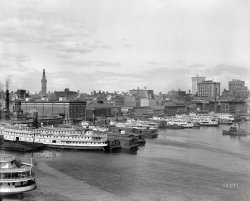
- Silent Night (colorized): 1940
- Woodstock, VT. Main Street, 1940. View full size.
Great I am a pharmacist and seeing that drugstore really brought me back.
(Christmas, Colorized Photos, Holidays) ... Posted by Dennis Klassen - 05/10/2010 - 1:57pm -
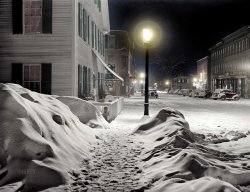
- Belle of Bohemia: 1900
- ... another cast member and is not on the list of the opening night cast members.
And in the background... If I'm making it out ... received mixed reviews in New York.
Music of the Night? This place looks like the perfect setting for Phantom of the Opera. ... Posted by Dave - 07/24/2012 - 7:16pm -
![Belle of Bohemia: 1900 New York City circa 1900. "Casino Theatre, Broadway." 8x10 inch dry plate glass negative, Detroit Publishing Company. View full size.
Poop patrol"Watch your step boys, because the street sweepers haven't made it this far yet."
Evelyn Nesbit again!It seems that the next production at the Casino, after "The Belle of Bohemia", included the lovely Evelyn Nesbit in the cast.
http://www.ibdb.com/production.php?id=5407
http://www.ibdb.com/person.php?id=54396
She was apparently a replacement for another cast member and is not on the list of the opening night cast members.
And in the background...If I'm making it out correctly, in the background is the Knickerbocker Theater playing "L'Aiglon" starring Maude Adams. From Wikipedia:
L'Aiglon (1900) was a French play about the life of Napoleon II of France in which Adams played the leading role, foreshadowing her portrayal of another male (Peter Pan) five years later. The play had starred Sarah Bernhardt in Paris with enthusiastic reviews, but Adams's L'Aiglon received mixed reviews in New York.
Music of the Night?This place looks like the perfect setting for Phantom of the Opera.
Unusual "Moorish Revival" buildingBoy, they don't make them like they used to! This must have been inspired by buildings like the Alhambra and the mosque at Cordoba, both in Spain.
BoBHere's the Internet Broadway Database entry on The Belle of Bohemia:
http://www.ibdb.com/production.php?id=5365
It says that the show closed on November 10, 1900, and the sign near the corner says "Last Nights!" so I suppose that puts the picture in early November or so.
It must have been a warm November for the lack of overcoats.
Fancy Fire EscapesOr are those stairs for accessing the levels where the seats are? I also wonder where one would go to purchase a ticket since there doesn't seem to be the usual ticket booth. Not that it matters -- I'd spend all of the allotted time standing on the sidewalk gazing at that amazing building.
MaudHere is an extended review of Maude Adams acting in "l'Aiglon" from the New York Times, Oct. 28, 1900
http://query.nytimes.com/mem/archive-free/pdf?_r=1&res=9806EEDF143FE433A...
AntiquesI like the antique shop...of course, everything in this photo (including the photo itself) is now an antique! Also like the early lighted signs for the different theatres. Great White Way, Version 1.0.
Fasten Those Buttons Below the KneesJust seeing Maude Adams would have been well worth the price of admission at the Knickerbocker. A timeless beauty.
Perfecto!A Theater that lives up to the Play! Love the two young gentlemen crossing the street. Exquisite details abound!
Puzzling appurtenancesA lot of puzzling appurtenances attached to this building-
like what are those circular iron rings atop the cupola for?
StunningTurn-of-the-Century architecture usually takes my breath away; this theatre is Exhibit A.
What a shame this was demolished (I was surprised to see it was in 1930; I figured it had to have been in the late 50s.) I can only imagine what it was like to view a performance here.
Bohemia still existed at the timeFunny. The State of Bohemia still existed in 1900. Actually, it was the Kingdom of Bohemia, an integral part of the Austro-Hungarian Empire. In fact, at one point in the mid-19th century, the Empire of the Habsburgs had seriously considered officially naming the empire as the "Triple Monarchy" aka the Empire of Austria-Hungary-Bohemia. But the Hungarian part of the crown did not want to share that glory with the smaller Bohemian state, and only wanted it to remain as the Dual Monarchy of Austria-Hungary. Just as well. At the end of WWI, the Empire was dismantled at the insistence of the victorious Allies. Austria became a much smaller nation (and later annexed by Hitler). Hungary became an independent republic. And Bohemia transformed into the modern state of Czechoslovakia (later broken up into the Czech Republic and the Slovak Republic).
Antique AntiquitiesI would LOVE to spend an hour in the antiquities auction rooms!
The Monster That Ate ChildrenThat's maybe the spookiest building I've ever seen. Most of the windows are filled with teeth!
And isn't 50 cents an outrageous price for a matinee seat?
FantasticWhat a great photograph, simply magnificent.
Ornate Inside and OutWhat a fantastic corner this must have been, with the old Metropolitan Opera House right across the street! The Casino was just as garish on the inside as on the outside, and featured Broadway's first roof garden. It's too bad the Schuberts didn't decide to keep it; surely it would be a landmark house today.
Antiques?I always find it fascinating that there were stores selling antiques at the turn of the century - I'd be happy today with something they were selling as "new" back then!
But ...Seems funny to think in 1900 they sold "antiquities."
Scary ThoughtWhen I saw the "busy" round sign on the corner I immediately thought it was the inspiration for Starbucks.
Pulled DownAccording to Wikipedia and The Internet Broadway Database, this pile of bricks was pulled down in 1930.
White Wing on the WayHe's working his way up the street, center right!
Buster BrownsAlmost impossible to believe (without this photographic evidence) that, before the logo, boys actually dressed like that!
QuestionCloser to the Knickerbocker there's a horse and carraige. Behind the carriage there's a man and bicycle. Where's the man's leg(s)?
[His one leg is visible behind the carriage wheel. - Dave]
(The Gallery, DPC, NYC, Performing Arts)](https://www.shorpy.com/files/images/4a08580a.thumbnail.jpg)
- Night Life: 1940
- November 1940. "Lincoln, Nebraska." Acetate negative by John Vachon. View full size.
Good Times Rollin' With the exception of the Ford (second from right), all of the cars photographed here are practically new. One has to wonder i ... Posted by Dave - 12/15/2019 - 12:27pm -
![Night Life: 1940 November 1940. "Lincoln, Nebraska." Acetate negative by John Vachon. View full size.
Good Times Rollin'With the exception of the Ford (second from right), all of the cars photographed here are practically new. One has to wonder if a similar present-day scene would reflect a comparable degree of apparent prosperity.
Where drama meets detachmentAnother exquisitely haunting (and Hopper-esque) shot by Vachon, master of composition and light.
It's cold outside?I know it was late Fall when he shot this area, likely cold and wet, but seems like compared to other government photogs of the time, an awful lot of his were just shot out his hotel room windows.
[John Vachon shot more than 11,000 exposures for the FSA. Less than one percent were "out his hotel room windows." - Dave]
Trouble with a capital "T"... and that rhymes with "P" and that stands for Pool! The first big step on the road to the depths of degradation -- at least according to Professor Harold Hill!
What a terrific picture.
(The Gallery, Cars, Trucks, Buses, John Vachon)](https://www.shorpy.com/files/images/SHORPY-8c18315a.thumbnail.jpg)
- Night Light: 1962
- August 1962. New York. "The George Washington Bridge with its good neighbor -- The Little Red Lighthouse." The Jeffrey's Hook Light on the Hudson River. AA batteries not included. New York World-Telegram and the Sun Newspaper Photograph Collection ... Posted by Dave - 08/18/2020 - 11:02pm -
![Night Light: 1962 August 1962. New York. "The George Washington Bridge with its good neighbor -- The Little Red Lighthouse." The Jeffrey's Hook Light on the Hudson River. AA batteries not included. New York World-Telegram and the Sun Newspaper Photograph Collection. View full size.
Another fence addedGoogle Maps has a reasonable approximation of this view. In addition to yet another fence around the bridge base, there's now a blimp in the sky!
https://www.google.com/maps/@40.8499289,-73.9462769,3a,37.5y,220.53h,106.2t/data=!3m8!1e1!3m6!1sAF1QipPJ1_2AVQwRdO-ux_83tXg4JQ6mcoNZotxT5FLR!2e10!3e11!6shttps:%2F%2Flh5.googleusercontent.com%2Fp%2FAF1QipPJ1_2AVQwRdO-ux_83tXg4JQ6mcoNZotxT5FLR%3Dw203-h100-k-no-pi-0-ya99.532005-ro-0-fo100!7i4000!8i2000
[Once again: How to embed a Google Map -- Dave]
The Little Lighthouse That CouldThis lighthouse and bridge are the subject of a still-popular children's book published in 1942: "The Little Red Lighthouse and the Great Gray Bridge".
The popularity of the book was instrumental in saving the lighthouse.
Written by Hildegarde Hoyt Swift (1890-1977).
Illustrated by Lynd Ward (1905-1985).
+ 58 YearsNot much has changed. This is from Google maps.
Little Lighthouse Tour to bootI visited in 2002 and have attached a few of my pictures from that time frame. Must be a popular spot to take a picture. The perspective of the bridge with the diminutive lighthouse under it is an appealing shot. We also arranged a tour of the inside. You have to contact the NY Rangers who meet you at the light. They have a big a** skeleton key that opens the door. At that point, the Fresnel Lens was still there. Don't know if it is now.... On further observation, it is clear from my picture and the Google image that the Fresnel Lens is still in place, but the 1962 image clearly does not have the Fresnel in place.
(The Gallery, Boats & Bridges, News Photo Archive, NYC)](https://www.shorpy.com/files/images/SHORPY-09079u.thumbnail.jpg)
- Friday Night Heavies: 1919
- Washington, D.C. "Tech High football, 1919." As soon as we're done with our homework, look out. 8x10 glass negative, National Photo Co. View full size.
Big ball That ball is half way to being a basketball, it is so fat.
Little kid ... Posted by Dave - 09/30/2016 - 1:29pm -
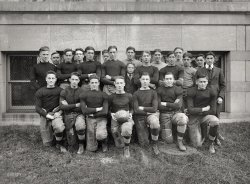
- Green for a Night: 1944
- March 1944. St. Patrick's Day dancers at the Washington labor canteen party sponsored by the United Federal Workers of America. View full size. Medium format safety negative by Joseph A. Horne for the Office of War Information.
Interracial ... Posted by Dave - 09/09/2011 - 2:31pm -
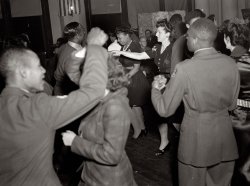
- My Mom's Prom Night
- This is a photo fo my mother on her prom night sometime in the late 1940's or early 1950's.
(ShorpyBlog, Member ... Posted by kmencher - 06/07/2007 - 4:29am -
- Fight Night: 1919
- Washington, D.C., 1919. "Boxing at Walter Reed Hospital." Another look at the proceedings first glimpsed here . National Photo glass negative. View full size.
Army Navy Hey you, Swabby over on the right! I see you hiding in the back! ... Posted by Dave - 08/14/2012 - 10:45pm -
![Fight Night: 1919 Washington, D.C., 1919. "Boxing at Walter Reed Hospital." Another look at the proceedings first glimpsed here. National Photo glass negative. View full size.
Army NavyHey you, Swabby over on the right! I see you hiding in the back! Get outta this ARMY facility now, on the double! Go over to Bethesda Naval Hospital and put on your own fights!
Services man's special!This must have been a fight put on for soldiers. There are more uniforms than civvies in the audience!
[Walter Reed Hospital was a U.S. Army medical facility. See the comments in the Shorpy posting linked in the caption. - tterrace]
Can't tell if this is ironic or convenientIronic for holding an activity in which injury commonly occurs at a place for healing, or convenient for having a boxing match at a place where medical personnel will be readily available!
(The Gallery, D.C., Sports, WWI)](https://www.shorpy.com/files/images/SHORPY_33398u.thumbnail.jpg)
- Night Riders: 1908
- Feb. 27, 1908. "A scrimmage." Polo team at Durland's Riding Academy in New York. View full size. 8x10 glass negative, George Grantham Bain Collection.
"Right there!" Looks like someone has committed a, er, um, "foul."
Love ... Posted by Dave - 09/11/2011 - 10:55am -
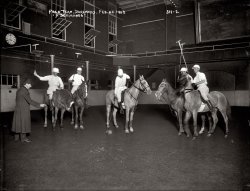
- All Lit Up: 1910
- ... Atlantic City, New Jersey, circa 1910. "The Boardwalk at night." 8x10 inch dry plate glass negative, Detroit Publishing Company. View ... in one place before.
Only the ghosts come out at night Here is as close to a comparative daytime view as I could find, ... Posted by Dave - 04/01/2023 - 1:37pm -
![All Lit Up: 1910 Atlantic City, New Jersey, circa 1910. "The Boardwalk at night." 8x10 inch dry plate glass negative, Detroit Publishing Company. View full size.
Double ChairsSmith's double chairs appear to be simply the famous Atlantic City rolling chairs for two. We know the exact date they were introduced there: June 11, 1887. TripAdvisor says that that 50-cent ride will cost you about $40 today.
Incredible detailOutstanding photo.
Somebody call GhostbustersI’ve never seen so many spectral bodies in one place before.
Only the ghosts come out at nightHere is as close to a comparative daytime view as I could find, looking down from the Hotel Traymore about four years earlier. The only sign I can see for sure in both photos is Moerlein's Barbarossa, which Google tells me is a dark lager brewed in Cincinatti, Ohio.
I couldn't identify any of the 1910 buildings in Street view. Based on where the Hotel Traymore was located and a slight dogleg in the boardwalk that you can see in the 1906 photo, here is where I think the nighttime photo was taken, on the boardwalk at S Kentucky Avenue.
Early neon lights?The Moerlein's and Spearmint signs appear to be neon lights. If so, they must be very early examples of that art form.
[Light bulbs only -- no neon. - Dave]
Boardwalk rolling chairsAt one period after this photo two rolling chair lanes were created with boards going the opposite direction which created a smoother ride for rolling chair riders. All the rolling chairs in the photo have hard tires. Only one company (Eveler) had rolling chairs with balloon tires. The others (Shill, G. George, etc.) used hard rubber.
(The Gallery, Atlantic City, DPC)](https://www.shorpy.com/files/images/SHORPY-4a55246a.thumbnail.jpg)
- Night Freight: 1943
- January 1943. "Freight operations on the Indiana Harbor Belt railroad between Chicago and Hammond, Indiana. At 8:45 p.m. the train arrives at its destination." Photo by Jack Delano for the Office of War Information. View full size.
Many co ... Posted by Dave - 08/29/2016 - 8:49pm -
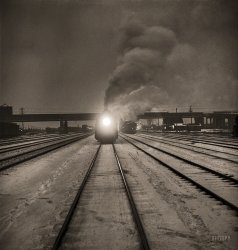
- Blues in the Night: 1941
- May 1941. "In the convict camp at Greene County, Georgia." The guitarist is bluesman Buddy Moss. Photo by Jack Delano. View full size.
They've Got a Right to Sing the Blues It's a tribute to these guy's spirit that they could enjoy ... Posted by Dave - 08/29/2013 - 9:50am -
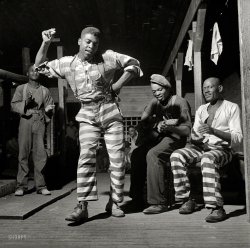
- Night Maneuvers: 1941
- May 1941. "Soldiers from a nearby Army camp waiting for the bus in Anniston, Alabama." Medium format negative by Jack Delano. View full size.
Transparent Soldiers? Why do the light streaks from passing vehicles pass behind the signs and ... Posted by Dave - 12/11/2018 - 10:33am -
![Night Maneuvers: 1941 May 1941. "Soldiers from a nearby Army camp waiting for the bus in Anniston, Alabama." Medium format negative by Jack Delano. View full size.
Transparent Soldiers?Why do the light streaks from passing vehicles pass behind the signs and mailbox but in front of the soldiers?
[Because they weren't standing there when the cars went by. - Dave]
Fort McClellanThe "nearby Army camp" would have been Camp McClellan (later Fort McClellan, which was closed in 1999).
Noble BusinessesThe soldiers are standing at the side of the Farmers Supply Company at 801-803 Noble Street. Some earlier sources give the address as 715 Noble. They sold a plethora of different goods including International trucks, farm and industrial tractors and equipment, buggies, wagons, feed, seed, harnesses, stoves, etc.
Also seen in the photo are the following businesses.
800-802 Noble: The Model Laundry
804-808 Noble: Farmers Supply Co. Used Cars
818-822 Noble: Callahan Grinding & Machine Co., Inc.
The picture below shows the front of the building, which burned down in the 1980s. All of the other structures are now gone as well.
"A Wandering Minstrel, I"Posters in the window feature an advert for the Rabbit's Foot Minstrels, a once famous traveling show that featured Black talent across the segregated South of the Jim Crow era, most famously through the Mississippi Delta region and beyond. During the 40's a Billboard ad tabbed the program as "the Greatest Colored Show on Earth"and seeking "Comedians, Singers, Dancers, Chorus Girls, Novelty Acts and Musicians." It was owned by various people until its ultimate demise as times and tastes changed in 1959. An historical roadside marker in Port Gibson, MS touts the impact of the Rabbit's Foot troupe on the development of blues music in American culture.
(The Gallery, Jack Delano, Small Towns)](https://www.shorpy.com/files/images/SHORPY-8c05782a.thumbnail.jpg)
- Voices of the Night: 1910
- Portland, Maine, circa 1910. "Longfellow family tomb, 2nd from right, Western Cemetery." Resting place of poet Henry Wadsworth Longfellow, author of "Paul Revere's Ride," "The Song of Hiawatha" and other classics. 8x10 inch dry plate glass negativ ... Posted by Dave - 10/25/2016 - 11:12am -

- Poker Night
- Poker night with the boys, sometime in the late 40's. Grandpa Frank is 2nd from left. ... Posted by mhallack - 04/11/2009 - 5:39pm -

- Motown Morning: 1942
- ... from the Y there was a strong sulfur aroma in the cold night air from the use of coal for industry and home heating.
(The ... Posted by Dave - 05/08/2024 - 3:54pm -
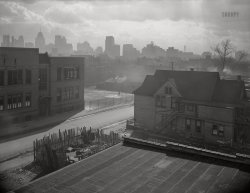
- The Night Porter: 1942
- March 1942. "Alfred MacMillan, Pullman porter resting in the men's washroom aboard the 'Capitol Limited' bound for Chicago." Acetate negative by Jack Delano. View full size.
Sam McGee Robert Service wrote of a porter who declined an off ... Posted by Dave - 03/18/2020 - 12:32am -
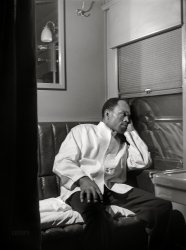
- Boys' Night Out: 1932
- Washington, D.C., or vicinity in 1932. "NO CAPTION (boys cooking over campfire next to NO TRESPASSING sign)." Possibly friends with these lads , or at least neighbors in this sequence of Harris & Ewing negatives. View full size.
... Posted by Dave - 06/04/2014 - 3:30pm -
![Boys' Night Out: 1932 Washington, D.C., or vicinity in 1932. "NO CAPTION (boys cooking over camp­fire next to NO TRESPASSING sign)." Possibly friends with these lads, or at least neighbors in this sequence of Harris & Ewing negatives. View full size.
Yet anotherOff-center belt buckle!
Doesn't that sign read ...NO TRESSPASSING?
[Oopss. -Dave]
BrylcreemLooks like the kid in the middle used a lot more than a little dab....
(The Gallery, Camping, D.C., Harris + Ewing)](https://www.shorpy.com/files/images/SHORPY-36847a.thumbnail.jpg)
- A Night at the Round Table: 1967
- 1967. Susie and Oliver Baugher relaxing in their Waynesboro, Virginia, home. Their house was genuine mid-century modern but their style and grace were from another era. The perfect hosts, they always made you feel good about yourself (style and gr ... Posted by ChuckB - 01/29/2018 - 10:04am -
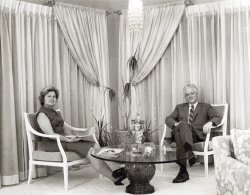
- Friday Night Lions: 1952
- November 1952. A pep talk from Coach. "Hamlet (North Carolina) High School football team in locker room at away game." From photos by Douglas Jones for the Look magazine assignment "Football Weekend." View full size.
It's Halftime ... Posted by Dave - 12/01/2013 - 8:09pm -
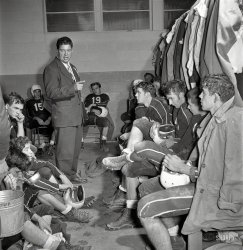
- Night and Day: 1947
- "Portrait of Billie Holiday at the Downbeat club, New York, ca. February 1947." Medium format negative by William Gottlieb. View full size.
I especially tried to capture personality, but that's an elusive qu ... Posted by Dave - 02/08/2019 - 9:08pm -
![Night and Day: 1947 "Portrait of Billie Holiday at the Downbeat club, New York, ca. February 1947." Medium format negative by William Gottlieb. View full size.
I especially tried to capture personality, but that's an elusive quality, and I was successful only a portion of the time. But I certainly hit it on the button here with a picture of Billie Holiday, whose voice was filled with anguish. I also tried to catch the beauty of her face -- she was at her most beautiful at that particular time, which was not too long after she had come out of prison on a drug charge. She couldn't get at any drugs while she was incarcerated, or alcohol, and she lost weight and she came out looking gorgeous, and her voice was, I think, at its peak. And I was fortunate enough to have spent some time with her during that period, and I caught this close-up of her in a way that you could really see the anguish that must have been coming out of her throat.
-- William Gottlieb, 1997
Party BillI naively thought that William Gottlieb only took sedate pictures of boutiques and modernist houses. This recent series of jazz singers and 52nd Street scenes shows a whole other side of him. He had his finger on the pulse of the city!
[You're confusing Sam Gottscho with Bill Gottlieb. - Dave]
Gee, you're right, sorry! Although there was a rumor Sam liked an occasional sarsaparilla.
Gotta wonder ...what patrons at the Downbeat Club thought when they saw that bruise (?) on her arm. Love the old jazz singers and instrumentalists, but I have to wonder whether too much of that beautiful music was caused, so to speak, by bruises like that.
The bestIf I could only listen to one musician/group for the remainder of my life, it would be Billie Holiday.
(The Gallery, Music, NYC, William Gottlieb)](https://www.shorpy.com/files/images/SHORPY-Billie_Holiday_1947_1.thumbnail.jpg)
- Streetcar by Night: 1976
- ... every so often a streetcar would roll by. On a warm, humid night, the open windows of the streetcar afforded a cooling breeze and a great ... Posted by Angus J - 03/23/2018 - 4:51pm -
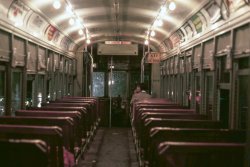
- Nether Again: 1900
- ... Dave]
Carbon Arc Lamps Which would literally turn night into a nightmarish form of day. They're so bright.
We used to have ... Posted by Dave - 05/02/2024 - 4:57pm -
![Nether Again: 1900 New York, 1900. "Hotel Netherland, Fifth Avenue and 59th Street." Our sixth look at this historic hostelry. 8x10 inch glass negative, Detroit Photographic Company. View full size.
I can't prove itBut I think I am descended from the lady in the far right of the photo with the huge black bow on her head and what I suspect is a perpetually quizzical look on her face. That snazzy skirt gives it away too.
Complicated then, forgotten nowPark and Tilford, founded in 1840, were ... well let's just call them "grocers." The actual history seems to be as involved as 220,877 newspaper hits might suggest. An importer of fine foods, after Prohibition they became known for a line of whiskies.
Bryan-StevensonNote the Tammany Hall banner promoting the Democratic presidential ticket of William Jennings Bryan and Adlai Stevenson, who ended up losing the 1900 election to William McKinley and Teddy Roosevelt.
Illuminate usIs that a gas or electric light in the foreground?
[Carbon arc lamp. - Dave]
Carbon Arc LampsWhich would literally turn night into a nightmarish form of day. They're so bright.
We used to have WWII surplus arc lamp spotlights at our state fair that would send beams tens of thousands of feet into the air. Some idiot sold them to a company in Houston.
Snazzy skirtThe distinctively-patterned skirt on the 1900 avatar of JennyPennifer on the far right is remarkably similar to the skirt on the woman behind her and to the left a bit. Is it simply a coincidence, a fashion of the day, or some photographic effect?
(The Gallery, DPC, NYC, Streetcars)](https://www.shorpy.com/files/images/SHORPY-4a08183a.thumbnail.jpg)
























